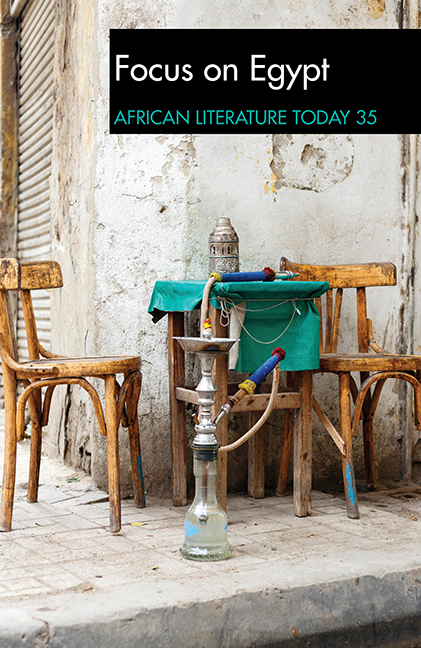Book contents
- Frontmatter
- Dedication
- Contents
- Notes on Contributors
- Foreword
- EDITORIAL ARTICLE
- ARTICLES
- Coping with a Failed Revolution: Basma Abdel Aziz, Nael Eltoukhy, Mohammed Rabie & Yasmine El Rashidi
- The Complications of Reading Egypt as Africa: Translation & Magdy el-Shafee's مترو (Metro)
- Narratives of the ‘Nubian Awakening’: Reclaiming Egypt's African Identity
- Frantz Fanon's Conceptualization of Decolonization in Sonallah Ibrahim's The Committee
- Romance as Epistemological Aesthetic in the Fiction of Ahdaf Soueif
- Literature as Prophecy: Re-Reading Yusuf Idris's The Cheapest Nights
- Travel & Discovery: Hopes for a New Egypt in Mohamed Salmawy's Butterfly Wings
- The Symbolic Relevance of the Use of the Eye in Nawal El Saadawi's Two Women in One & God Dies by the Nile
- African Epics: A Comparative Study of Sundiata & Al-Sirah al-Hilaliyyah
- Conversations with Nawal El Saadawi: Online interview
- FEATURED ARTICLES
- LITERARY SUPPLEMENT
- TRIBUTE
- REVIEWS
- Reviews of Nigerian Poetry
The Symbolic Relevance of the Use of the Eye in Nawal ElSaadawi's Two Women in One & God Dies by theNile
from ARTICLES
Published online by Cambridge University Press: 24 August 2019
- Frontmatter
- Dedication
- Contents
- Notes on Contributors
- Foreword
- EDITORIAL ARTICLE
- ARTICLES
- Coping with a Failed Revolution: Basma Abdel Aziz, Nael Eltoukhy, Mohammed Rabie & Yasmine El Rashidi
- The Complications of Reading Egypt as Africa: Translation & Magdy el-Shafee's مترو (Metro)
- Narratives of the ‘Nubian Awakening’: Reclaiming Egypt's African Identity
- Frantz Fanon's Conceptualization of Decolonization in Sonallah Ibrahim's The Committee
- Romance as Epistemological Aesthetic in the Fiction of Ahdaf Soueif
- Literature as Prophecy: Re-Reading Yusuf Idris's The Cheapest Nights
- Travel & Discovery: Hopes for a New Egypt in Mohamed Salmawy's Butterfly Wings
- The Symbolic Relevance of the Use of the Eye in Nawal El Saadawi's Two Women in One & God Dies by the Nile
- African Epics: A Comparative Study of Sundiata & Al-Sirah al-Hilaliyyah
- Conversations with Nawal El Saadawi: Online interview
- FEATURED ARTICLES
- LITERARY SUPPLEMENT
- TRIBUTE
- REVIEWS
- Reviews of Nigerian Poetry
Summary
Symbolism is toliterature what a good wine is to a good dinner. In thisregard therefore, writers have used concrete symbols toinvest things with a representative meaning or have usedartistic methods of revealing ideas or truth through the useof symbols. Visual and concrete terms can easily representabstract terms and thus give form to the formless. Nawal ElSaadawi is renowned for the use of deliberate powerfuldiction which often has underlying meanings. This enquiryexamines her language use, especially the recurrent use ofthe word ‘eye’ and its varied colours as an indicator to thecentral meaning and understanding of two of her novels,Two Women in One and God Diesby the Nile. Consequently, it is through thesymbolic presentation of the ‘eye’ that the reader sees theauthor's themes unravel themselves.
Literally, asymbol is said to be a thing that stands for somethingbeyond itself. This is to say that a symbol must always beconsidered beyond its outward presentation. Symbolism hasbeen defined in various ways. For example, Arthur Symons inThe Symbolist Movement in Literaturerefers to it as ‘visual or pictorial’. Robin Mayheadbelieves that, in writing, ‘[i]magery is something bodiedforth by the writer's imagination’ (UnderstandingLiterature: 135). This means that, throughimagination, contrasting symbols and images can beartistically brought to bear on our reality, thus giving ‘usa completely new and refreshing sense of the world in whichwe live’ (135).
In the samevein, Fowler sees symbols in literature as attributes of anobject ‘which serve the rational idea as a substitute forlogical presentation, but with the proper function ofanimating the mind by opening out for it a prospect into afield of kindred representations stretching beyond its ken’(Dictionary of Modern Critical Terms:188).
Additionally,William Butler Yeats in The Symbolism ofPoetry (1900) maintains that a ‘continuousindefinable symbolism’ is ‘the substance of all style’, andthat ‘the excellence of symbol consists in thesuggestiveness that derives from the suppression of ametaphor's directly apprehensible terms of reference: “as asword blade may flicker with the light of burning towers”,so the symbol evokes unseen worlds’ (quoted in Fowler:188).
- Type
- Chapter
- Information
- ALT 35: Focus on EgyptAfrican Literature Today 35, pp. 120 - 131Publisher: Boydell & BrewerPrint publication year: 2017



